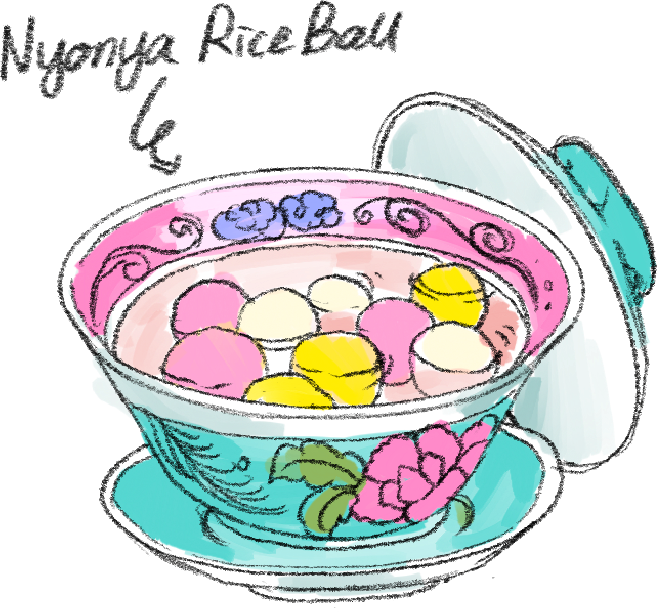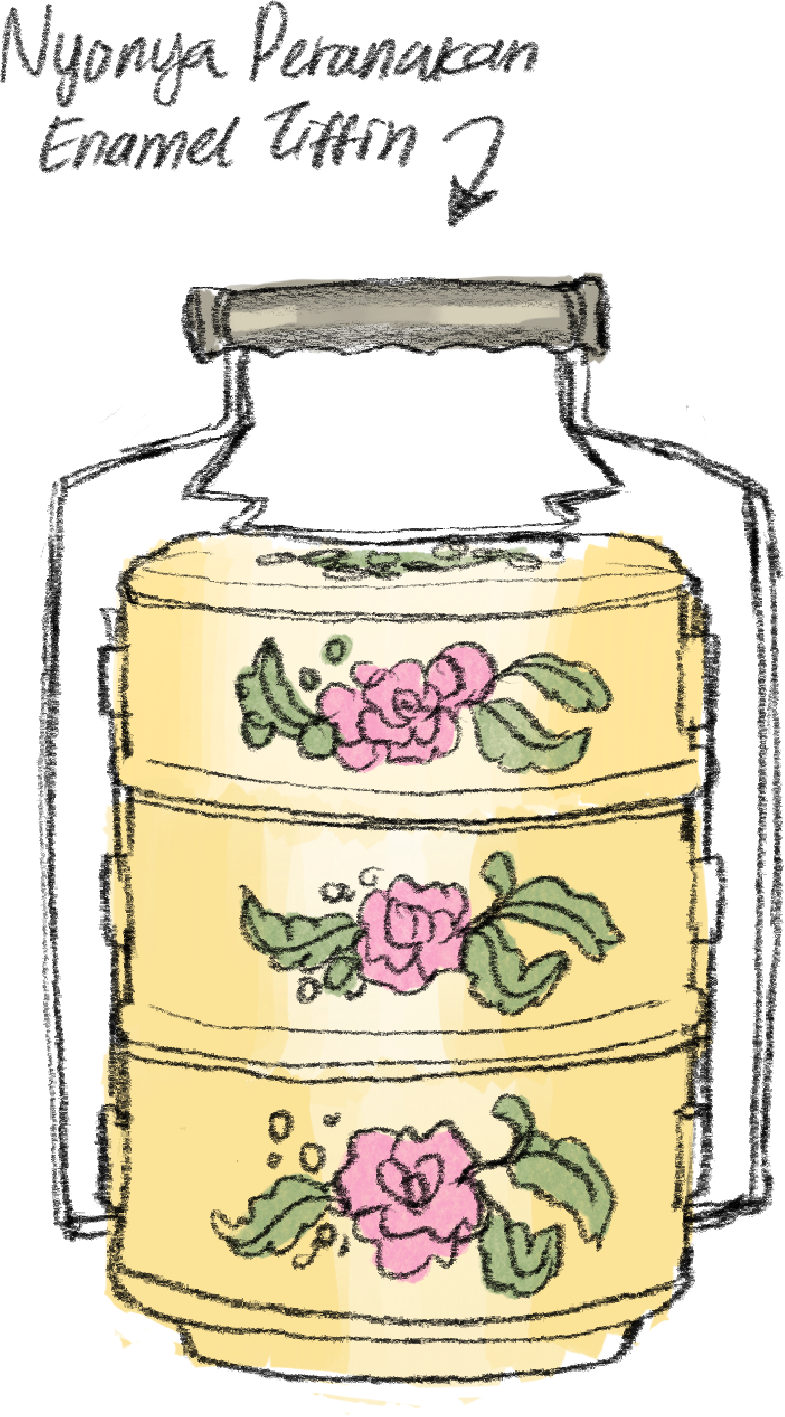Nyonya Delights
A Bite of Tradition: Nyonya Kuih's Perfect Fusion of Flavours
Kuih. The word ‘Kuih’ is enough to evoke nostalgia and tempt taste buds with its array of unique local flavours. Nyonya Kuih is a staple in Southeast Asian cuisine, particularly in Malaysia and Singapore. These finger-licking treats are known for their vibrant colors, authentic local flavours, and adorable bite-sized shapes
Nyonya Kuih and the Peranakan Culture
Nyonya Kuih is part of the distinctive culture of Straits Chinese Peranakan, resulting from the intermarriage of Chinese immigrants and local Malays in the 16th century. The Peranakan's language, clothing, art, and cooking continue to be celebrated today. Nyonya Kuih is noted to be a reformulation of the traditional Malay Kuih with native Chinese expertise through some tweaks in the recipe inspired by their culinary expertise and palate.
From Sweet to Savory: Kuih for Every Palate
1. Nyonya rice ball

1. Nyonya rice ball
During the Winter Solstice Festival, the Peranakans would traditionally eat Kueh Ee, also known as 'tang yuan' (汤圆) in Mandarin, or in English - Glutinous Rice Balls. These glutinous rice balls are colored red, white, and occasionally green, and made either plain or with filling. They are served in ginger-flavoured sugar syrup. The round shape of the glutinous rice balls symbolizes the importance of family unity. Additionally, in the past, this dish was customarily served to newly married couples on their wedding day as a symbol of the longevity of their partnership.
2. Chwee Kueh

2. Chwee Kueh
Chwee Kueh, or 水 粿 in Mandarin, is a type of steamed water rice cake that is typically topped with sweet and savory Chai Poh (preserved turnip). The cake is made by combining water, rice flour, and other gluten-free flour such as tapioca flour, wheat starch (not all-purpose flour), and cornstarch, before steaming it to a soft, pudding-like texture. The cake is characterized by a distinctive "dimple" on top and is usually topped with savory and sweet Chai Poh before being served with sambal chili.

3. Steamed rice cake

3. Steamed rice cake
Steamed Rice Cake, also known as "Bai Tang Gao" in Mandarin is a type of steamed cake made from a simple mixture of rice flour, sugar, yeast, and water. This cake is known for its soft and bouncy texture and slightly sweet taste. It is characterized by its signature pale white color and honeycomb texture inside the cake. A successful Bai Tang Gao should present a honeycomb texture in the center and taste chewy after cooling down.
4. Kuih Lapis

4. Kuih Lapis
Despite its soft and wobbly appearance, every bite of the Kuih has a firm and springy texture, and the richness of the coconut milk adds to its overall flavour. I is steamed gradually, and layers are subsequently added in alternating order to avoid different colors mixing together. However, the layers are very resilient and do not tear easily which makes it peeling layer by layer so much fun. Locals enjoy eating Kueh Lapis by tearing it layer by layer, and savoring the different colors and flavours with each bite.

5. Huat Kueh

5. Huat Kueh
Huat Kueh, also known as Fagao in Mandarin, is a steamed rice flour cake that is beloved in Southeast Asian cuisine, particularly in Singapore and Malaysia. This Kuih is characterized by its unique "huat" or "prosperous" rising effect during steaming, which causes the cake to split open at the top and form a flower-like shape. The higher the bloom on the Kuih, the greater the prosperity it is said to bring in the future.
Typically made with rice flour, sugar, water, and a leavening agent such as baking powder or yeast, Huat Kueh can also be flavoured with pandan or other ingredients for added taste and aroma. It's a popular snack or dessert, especially during festive occasions like Chinese New Year.
6. Ang Ku Kuih

6. Ang Ku Kuih
Ang Ku Kuih, also known as red tortoise cake, is a type of glutinous rice cakes with various sweet fillings served on a banana leaf. In the Hokkien dialect, ‘ang’ means red while ‘ku’ refers to the tortoise, which is literally a reference to the appearance of the Kuih. Tortoise signifies longevity and red symbolizes prosperity.
Red tortoise cake is a traditional folk festival food symbolizing a long and healthy life. Originally, live turtles were used as sacrifices for longevity, but the turtle-shaped pastry Ang Ku Kuih replaced them as they became scarce.

7. Pineapple Tart

7. Pineapple Tart
Huat Kueh, also known as Fagao in Mandarin, is a steamed rice flour cake that is beloved in Southeast Asian cuisine, particularly in Singapore and Malaysia. This Kuih is characterized by its unique "huat" or "prosperous" rising effect during steaming, which causes the cake to split open at the top and form a flower-like shape. The higher the bloom on the Kuih, the greater the prosperity it is said to bring in the future.
Typically made with rice flour, sugar, water, and a leavening agent such as baking powder or yeast, Huat Kueh can also be flavoured with pandan or other ingredients for added taste and aroma. It's a popular snack or dessert, especially during festive occasions like Chinese New Year.
The Unique Blend of Ingredients and Spices
The fusion of Chinese and Malay cultures is reflected in the ingredients and flavours used in Nyonya Kuih. Each Kuih is made with a unique blend of ingredients and spices, resulting in a diverse range of flavours and textures. Kuih generally uses glutinous rice as a key ingredient with local spices and flavours like pandan leaves, palm sugar (gula melaka), and coconut milk. A mixture of rice flour, mung bean starch or tapioca flour, blended with creamy coconut milk and flavoured with sugar and subtle hints of salt, creates the base for a range of tantalizing desserts. Fragrant Pandan leaves, similar in aroma to vanilla, are often added for extra depth.
These delicacies are then steamed to create a tender, bouncy jelly-like texture, while the addition of unique ingredients like glutinous rice, yam, sweet potato, shredded coconut, sago, palm sugar, and blue butterfly pea give a special touch to each delectable treat. Kuih typically has a soft and chewy consistency with a bouncy texture, and the flavours can be sweet or savoury. Kuih is handmade and commonly steamed, thus having a slightly sticky texture and richer flavour than Western desserts.
The recipes are passed down orally from generation to generation. Each matriarch has her own distinct taste notes, which family members fondly remember. It is said that they can spontaneously replicate these recipes whenever they step into the kitchen.

Nyonya Peranakan Enamel Tiffin
Enamel tiffin carriers also known as Tingkat, is a traditional food carrier used by the Peranakan community to carry a variety of dishes. It is a multi-tiered container made of enamel with each tier consisting of a small, lidded container that can be stacked on top of each other.
Nyonya Kuih still remains a beloved Malaysian dessert that continues to be enjoyed throughout the year, but especially during religious and cultural celebrations. Certain types of Kuih hold a greater significance and importance than others during specific commemorative days.

Nyonya Kuih has become an integral part of Malaysian food culture. Its intricate and delicate preparation methods have been passed down through generations of Peranakan families, resulting in a diverse range of flavours, colors, and textures that make each Kuih distinct. From the sweet and chewy Kuih Lapis to the fragrant and moist Kuih Talam, Nyonya Kuih is more than just a dessert - it is a reflection of the vibrant and diverse community that created it. Whether you are a local or a visitor to the region, Nyonya Kuih is a must-try delicacy that will leave a lasting impression on your taste buds.
